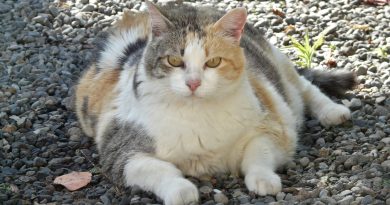Indoor or Outdoor Cats?


Life outdoors- even for just short periods – can be deadly. Cats allowed outdoor are more at risk of catching illness. Diseases such as FIV (Feline Immunodeficiency Virus) have no inoculation and no cure. Cats are more at risk of being hit by vehicles. They can become food for wild animals such as coyotes (which adapt well to our suburbs).
They are more likely to get into fights and develop abscesses from bites. They are more at risk of irate neighbors sick of cats digging up gardens and sleeping on cars. They are at risk of theft and torment. In some communities, you can be held liable for any damage your cat does off your property. In others, people may be able to trap or even kill cats causing damage.
The average lifespan of the outdoor cat is about five years. (Remember, averages take into consideration the kitten killed very young when outside and the cat who makes it into senior year and goes outside). Outdoor cats have a greater chance of contracting and carrying Toxoplasmosis. Toxoplasmosis is very bad for women of childbearing age as the parasite can be harmful to a developing fetus leading to things such as retinal problems or hydrocephaly.
Even healthy cats can harbor the parasite. Unspayed or unneutered cats that go outside also add greatly to overpopulation and even feral colonies develop – creating a health risk. Outdoor cats are a danger to wildlife – especially in the spring when young animals are just learning how to live.
But let’s look at indoor cats. I have five. All are kept indoors. If they go out, it is on lead and in the back yard. The biggest complaints I hear from owners of indoors exclusively cats are: scratching, litter box smell and lack of doing what cats do naturally. Well, the scratching can be controlled by providing and encouraging the use of scratching posts. Different surfaces (carpet, sisal and even wood) as well as tall enough for the cat to fully stretch and climb – and laced with catnip – plus training can help save furniture. That litter box door? Come into my house, you will notice very little odor. I cannot stand cat box smells!

I keep the litter boxes in the utility room. The door is kept closed and we installed a cat door for access (and keeps the dogs out of the boxes). I use a clumping litter and scoop out at least once a day. Each week, the box gets a total change. Every so often, the boxes get washed and dried in the sun and lightly oiled with mineral oil to help cut down on litter sticking to the plastic. The boxes are kept on a large indoor/outdoor mat and if the mat gets dirty or a cat misses the box, the mat can be taken out and hosed down. Yes, sounds like a lot of work.
However the cleaning takes less than three minutes a day for the daily scooping (six minutes if I have to scoop twice). The weekly total dumping takes my husband maybe five minutes. And the occasional washing can be fit into a schedule – if I am outside in the yard washing other things, just grab the boxes as well. Diligence helps cut down odors greatly.
So, what about boredom and cats being able to do what they do naturally like hunt? We can enrich their lives and let them hunt and pretend to kill in a safer and controlled manner. Cat toys can be expensive, so I make my own. A heavy sock rolled up with some catnip stuffed in it makes a great mouse! Wood dowels from the craft store with some bright ribbon tapes to the end makes a great "fishing pole" for you to encourage chasing.
Get small cubes or balls used to insert food in and let the cat have to work to get a reward. (If you leave food down all day for your cats, consider using one of these toys, or if you have multiple cats, a few balls, and use these to feed the cats from. This gets them hunting, active and helps burn calories!). Toilet paper tubes with a treat stuffed in them and the ends crumpled allow for scratching and tearing. Cats can hunt safely inside and have far fewer risks to themselves and to wildlife than if they hunt outside.
Now, what if you absolutely do not agree with cats being inside only? What can you do to help ensure safety? Consider building a cat play yard. A six by six by six cage (or larger) with a covered top. Put in logs to climb, things to chase and bat at, thick ropes to hang off of – look at the small cat habitats at the zoo for ideas! Your cat can go out but still be safe.
Cats can also be leash trained. Of course they may not follow you like a dog, but you and the cat can spend quality time outside together and the cat is far safer than if loose and unsupervised. (Even loose cats can take off and fast get out of your sight if unleashed). Just do not tie the cat up and then YOU walk away. The cat could get hurt.
All cats, whether inside or allowed out should be microchipped. With the improvement of microchip technology and the efforts of organizations like Home Again to try and get all shelters equipped with scanner, chipping offers an permanent form of ID. And ideally cats should have a secondary ID such as an identity tag. Just make sure they are on a safety collar incase the tags or collar get snagged. Even indoor cats may be at risk of escaping the house and should have some form of ID – just in case.
The choice of indoor or outdoor is personal, but one we have to take seriously. In this day and age, it is really safe to allow cats to roam loose? If you must allow your cat out, spay or neuter it, have ID on it, do not declaw outdoor cats and if you live near a busy road, forget it. And, be responsible for any damage your cat may do to other’s property.













